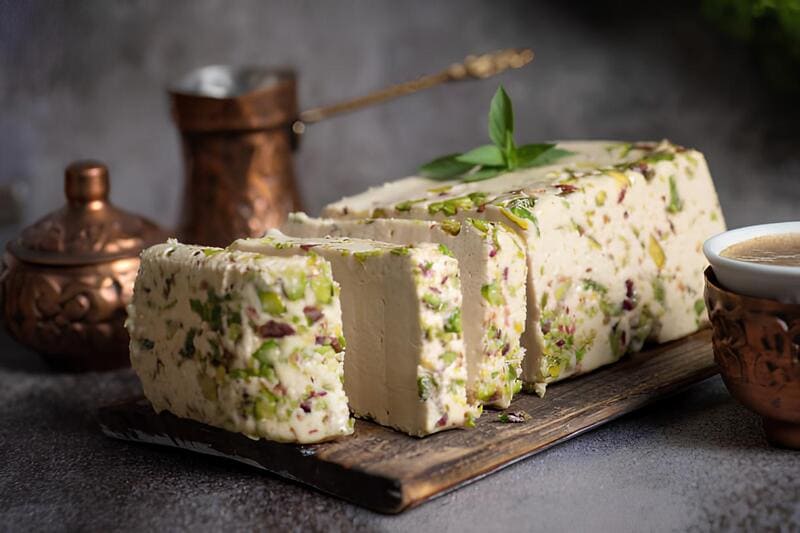
Halva, also known as Halawa Tahinia, is a beloved Egyptian dessert with roots stretching back to ancient times. It’s a dense, sweet confection primarily made from sesame seeds and resembles a sugary, nutty delight.
This traditional treat is often enjoyed during festive occasions and is available in many variations, including pistachio.Halva’s flavor profile is rich and nutty, with a subtle sweetness that’s perfectly complemented by the texture. It strikes a balance between crumbly and creamy, making it a unique sensory experience.
If you’ve ever wondered how do you make halva from scratch, this recipe will guide you through an authentic Egyptian method.
Ingredients
- 1 cup roasted sesame seeds
- 1 cup raw peanuts, roasted or unroasted
- 1 cup flour
- 2 cups neutral oil
- 1 cup sugar
- 1 cup water
- 1 tablespoon honey (or glucose syrup)
- 1 pinch of lemon salt (or juice of half a lemon)
Preparation
- In a large bowl, combine 1 cup of roasted sesame seeds, 1 cup of raw peanuts, and 1 cup of flour. Stir the mixture while heating until it is warm.
- Using a blender or grinder, process the heated mixture into a fine powder. Ensure the mixture remains warm throughout this step.
- Add 2 cups of neutral oil to the blender and blend the mixture until it achieves a smooth consistency, similar to thick milk.
- In a saucepan, combine 1 cup of sugar, 1 cup of water, 1 tablespoon of honey, and a pinch of lemon salt. Bring the mixture to a boil until it reaches a soft-ball stage, where a drop of the mixture in cold water forms a soft, pliable ball.
- Gradually pour the hot syrup into the tahini mixture while continuously blending. The mixture should become lighter in color and smooth.
- Grease a mold with a bit of oil and transfer the halva mixture into the mold. Allow it to cool and set up in the refrigerator overnight.
- The next day, you can demold and cut the halva into desired pieces for serving.
Did you know?
Halva is not only cherished in Egypt but across many cultures, each with its unique twist on the classic recipe. In Arabic cuisine, this sweet treat is often flavored with ingredients like pistachio and sometimes enhanced with cardamom or rose water. Surprisingly, halva can be quite healthy when enjoyed in moderation.
It’s packed with protein and healthy fats from the sesame seeds and peanuts, making it a nutritious dessert option. Moreover, the traditional process of making halva, known for being labor-intensive, ensures that you enjoy the best quality possible.
Halva is traditionally enjoyed with coffee or tea, offering a delightful contrast to the strong, bitter flavors of these beverages. The ancient Egyptians valued sesame for its nutritious properties and believed that it conferred immortality, making halva more than just a dessert but a historical treasure passed through generations. So, next time you savor this sweet treat, remember you’re biting into a piece of ancient tradition and culinary history.
